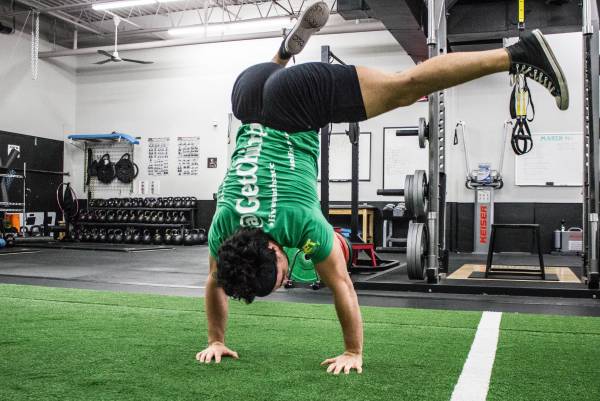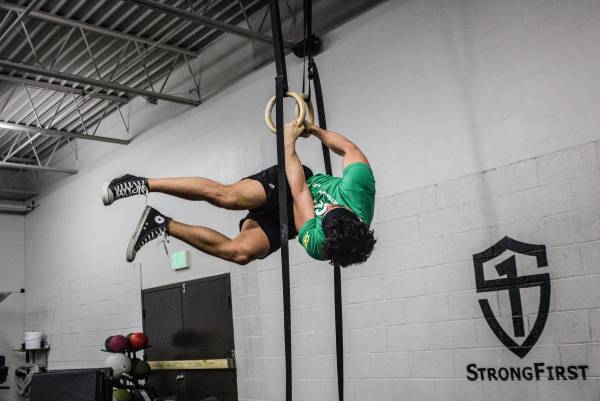In a previous article, I explained the difference between practicing, training, and testing, and how knowing this difference has helped me make better gains in my physical efforts. Today, I am going to dive deeper into getting great results through more effective practice.
Skill development is all about concentration, routine, and patience.
Here are five tips on what to do before, during, and after a training session focused on practice. While my aim is to improve my physical skills like bodyweight training, Olympic lifting, and the like, these five tips apply to any skill at which you wish to get better.
1. Clear Your Head Space
How often does your thinking go outside of what you’re currently working on? Stop that! The better you can focus on the specific task at hand, the better your results will be.
There are several different tools that can help you to do this. Eliminating distractions like a phone that could ring at any time is an obvious strategy, but finding the right focus also has a lot to do with your mental headspace.
By setting up your environment properly it can help you to keep the concentration you need. A clear space containing only what you need to use is best. To help keep you in the “practice mode,” it is also best if this space is only used for that purpose.
“If you can get some sleep right after any practice session, it appears that your body will use this time to help codify what you learned.”
Another thing that can help is music. I like to use the same music – actually the same exact album – each time I train. As soon as that first note begins, my body and mind instantly become ready.
Another tactic involves energy psychology. I explained this technique in this article, and it helps me get set before I begin.
2. Focus on a Single Move (or Two) at a Time
Circuit training certainly has its benefits, but practicing skill really isn’t one of them. For results in skill training, it is typically best to focus on one move at a time. This allows you to put your entire concentration on that move.
That said, since fatigue can be an issue, in some cases going back and forth between two unrelated exercises, can be an even better choice. Different physical skills may be better suited to one or another so it does depends on what you’re going for.

Limiting your focus to developing one or two skills is the key to mastery.
Here are some good options based on my personal experience:
Single Moves:
- Freestanding Handstand
- Press Handstand
- Kettlebell Juggling
- Pistol Squats
- Back Flips
Two Moves:
- Front Lever and Snatch (Olympic or Kettlebell)
- Military Press and Deadlift
- Handstand Push Ups and Pull Ups
- Human Flag and Stone Clean and Press
Don’t necessarily take any of these and use them as is or just because I suggested them. Instead, use these suggestions to give you some own ideas for what’s relevant and appropriate for you.
3. Hitting the Sweet Spot
In The Little Book of Talent by Daniel Coyle, the author uses the term “deep practice” to describe effective practice. This kind of practice is often marked with mistakes and failure, but not in a bad way and not to a great degree.
“Since strength isn’t just about muscle, but is heavily influenced by the nervous system, this is a roadmap to becoming much stronger.”
Coyle describes three zones of practice, and like Goldilocks and the three bears, we want to enter the zone that is just right:
- Comfort Zone – Percentage of successful attempts: 80% and above
- Sweet Spot – Percentage of successful attempts: 50-80%
- Survival Zone – Percentage of successful attempts: Below 50 %
What this means is that if you’re getting things right 100% of the time, chances are you’re doing something too easy. It is time for you to progress to the next step, whatever that may be. But if you’re missing the mark over half the time, you’re working on something that is too tough. Take it back and notch and try again. It’s in that middle ground – where something is challenging, but not too challenging – that you’ll best gain the skill you desire.
Note: Implicit within this discussion you must understand the principles of progression and how to apply it to whatever you’re working on.
4. The Qualities Associated With Good Practice
In Coyle’s earlier book, The Talent Code/, he developed a list of keywords that people engaged in good practice used to describe what that experience was like. In other words, this is how they said it feels to successfully work in that sweet spot. This list was taken from people engaged in different fields of practice, but all at high levels:
- Attention
- Connect
- Build
- Whole
- Alert
- Focus
- Mistake
- Repeat
- Tiring
- Edge
- Awake
Take inventory during your practice. Would you describe it in much the same way?
Not only can we use success or failure as measurement of our practice, but the feelings behind these keywords can also help us determine if we’re at the right place. Now we can both quantify and qualify good practice.

The best strength practice involves a combination of movement and mindfulness.
5. Post-Practice Follow-up
Practice isn’t just about what you do during practice. Myelin is the coating or sheath that surrounds nerves. As it builds up, the nerves become better conductors, which for our goal, translates into better skills. This is the physical component involved in wiring the nervous system. Thus, it’s important that your body is suited to formulating this material.
“How often does your thinking go outside of what you’re currently working on? Stop that! The better you can focus on the specific task at hand, the better your results will be.”
While there are no studies specifically on this issue, my belief is that making sure your foundational nutrition is covered, is going to help in skill building. Most important will be the high-quality fats like EPA and DHA, as well as a little heard of one called nervonic acid. This is because myelin is about 80% fat. Also the B vitamins and various minerals surely play their role here, too.
Another important piece of the practice puzzle is sleep. If you can get some sleep right after any practice session, it appears that your body will use this time to help codify what you learned. It’s kind of like this is when the skill is locked down into your nervous system. So if you can grab a nap, it may help you solidify your desired skill sooner and better.
Summarizing a Good Practice
While I could go much further into each one of these subjects, this list of five tips should be more than enough to accelerate your skill gains. To recap:
- Clear your headspace
- Focus on one or two moves at a time
- Hit your sweet spot
- Remember the qualities associated with good practice
- Have a good post-practice follow-up regimen
By applying these five steps to even something as basic as a push up, you’ll gain skill in it. That means you’re going to become stronger. Since strength isn’t just about muscle, but is heavily influenced by the nervous system, this is a roadmap to becoming much stronger.
Check out these related articles:
- Meta Programs – How to Adjust Your Thinking for Better Results
- How to Get Started With Kettlebell Juggling
- Why I Don’t Do “Conditioning” and You Don’t Have to Either
- What’s New On Pulse Beat Fit Today
References:
1. Coyle, D., The Little Book of Talent, (Bantam Books: 2012) 41-42.
2. Coyle, D., The Talent Code, (Bantam Books: 2019) 91-92.
3. Christopher, L., Practicing Strength and Movement, (Legendary Strength: 2015) 37-39, 76-79.
Photo 1 courtesy of Shannon Khoury.
Photos 2 and 3 courtesy of Josh “Chimpy” Halbert.






